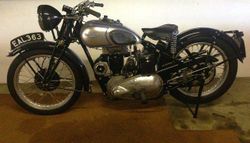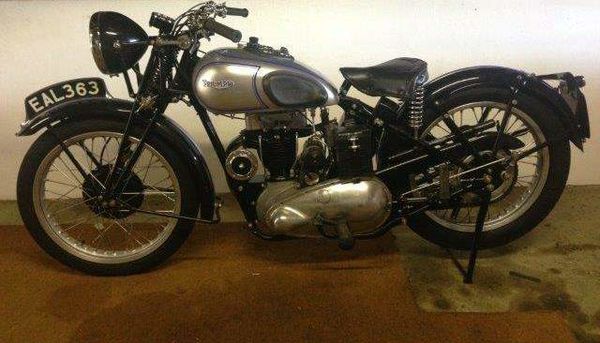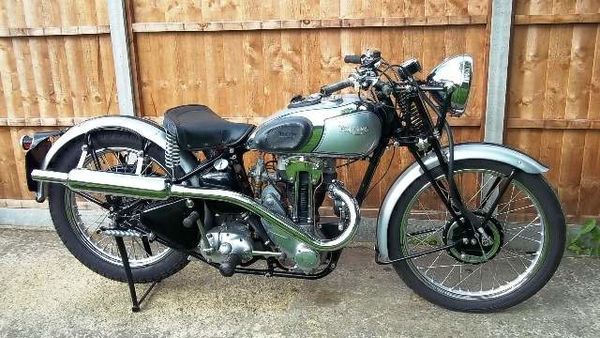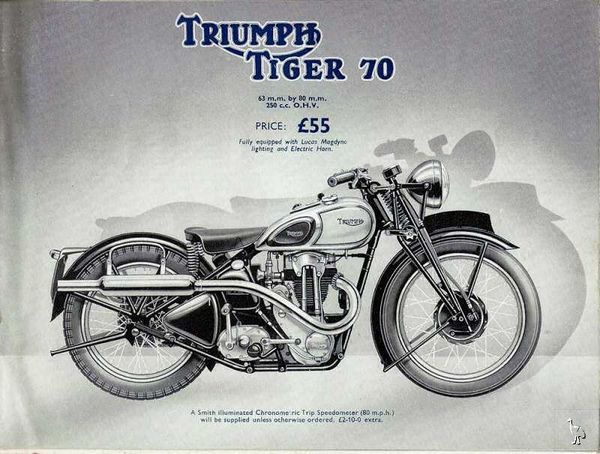Triumph Tiger 70
 |
|
| Triumph Tiger 70 | |
| Manufacturer | |
|---|---|
| Production | 1937 - 40 |
| Engine | |
| Top Speed | 104 km/h / 65 mph |
| Ignition | Lucas, 6V Magdyno |
| Frame | Single cradle, steel |
| Suspension | Front: Rigid, dual springs Rear: Rigid, spring loaded saddle |
| Brakes | Front: Drum Rear: Drum |
| Weight | |
| Oil Capacity | 3.4 L / 0.90 US gal / 0.75 Imp gal |
| Fuel Capacity | 12.5 L / 3.3 US gal / 2.75 Imp gal |
| Manuals | Service Manual |
It could reach a top speed of 104 km/h / 65 mph.
Engine[edit | edit source]
The engine was a Air cooled cooled Single cylinder, single port OHV with automatic lubrication to rockers and valve guides.
Chassis[edit | edit source]
Stopping was achieved via Drum in the front and a Drum in the rear. The front suspension was a Rigid, dual springs while the rear was equipped with a Rigid, spring loaded saddle. The Tiger 70 was fitted with a 12.5 L / 3.3 US gal / 2.75 Imp gal fuel tank.
Photos[edit | edit source]
Overview[edit | edit source]
Triumph Tiger 70
Jack Sangster, the owner of Triumph motor cycles from January 1936, moved Edward Turner across from Ariel, along with Bert Hopwood as Chief Draughtsman, in order to get something done to boost Triumph's flagging product line and sales figures. Val Page had produced good engines, and Turner acknowledged this, but they lacked the 'eye appeal' to attract customers.
With no time to design anew, and not really necessary as the 'basics' were good, Turner set to in providing that 'eye appeal' and also in providing a meaningful name. Thus, with small 'tinware' changes and 'shell blue sheen' replacing the drab black, by April Turner had three new models on the road for testing. The Model L2/1 became the Tiger 70, the Model 3/2 became the Tiger 80 and the Model 5/5 became top of the range Tiger 90. (The numbers gave an indication of their top speeds.)
Initially the original twin down-tube frames were used, and even the engine numbers continued their sequences, but with an addition to indicate that they were fitted to a Tiger. With time to make further improvements later models were given more sporting looking single down-tube frames and further 'tinware' improvements were made, and these three models continued through to 1939, being joined in their last year by a further 500cc Tiger model - the Tiger 100 Twin of 1939.
| Make Model | Triumph Tiger 70 |
|---|---|
| Year | 1937 - 40 |
| Engine Type | Single cylinder, single port OHV with automatic lubrication to rockers and valve guides |
| Displacement | 249 cc / 15.2 cu in |
| Bore X Stroke | 63 x 80 mm |
| Cooling System | Air cooled |
| Oil Capacity | 3.4 L / 0.90 US gal / 0.75 Imp gal |
| Exhaust | One into one |
| Ignition | Lucas, 6V Magdyno |
| Starting | Kick |
| Max Power | 11.9 kW / 16 hp @ 5800 rpm |
| Frame | Single cradle, steel |
| Front Suspension | Rigid, dual springs |
| Rear Suspension | Rigid, spring loaded saddle |
| Front Brakes | Drum |
| Rear Brakes | Drum |
| Front Wheel | 3.00 x 26", Dunlop ribbed |
| Rear Wheel | 3.25 x 26", Dunlop ribbed |
| Fuel Capacity | 12.5 L / 3.3 US gal / 2.75 Imp gal |
| Top Speed | 104 km/h / 65 mph |


